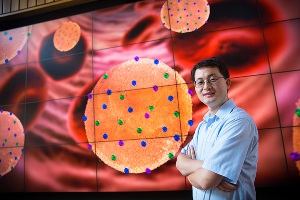Aug 22 2013
MIT Technology Review has named Liangfang Zhang, a professor of nanoengineering at the University of California, San Diego, among the top 35 young innovators of 2013. For over a decade, the global media company has recognized a list of exceptionally talented technologists whose work has great potential to transform the world.
 Liangfang Zhang. Image credit: Jacobs School of Engineering
Liangfang Zhang. Image credit: Jacobs School of Engineering
Zhang, who joined the faculty of the UC San Diego Jacobs School of Engineering in 2008, has been honored as a pioneer on the list for his work in nanotechnology and materials.
“I am thrilled to receive this prestigious recognition. It gives me and my research team an extra boost of motivation to pursue innovative technologies for improving human healthcare,” said Zhang.
The Zhang Research Group has developed a novel technology for cloaking nanoparticles in natural red blood cell membranes that can evade the body’s immune system. Using the body’s own red blood cells marks a significant shift in focus and a major breakthrough in the field of personalized drug delivery research. Trying to mimic the most important properties of a red blood cell in a synthetic coating requires an in-depth biological understanding of how all the proteins and lipids function on the surface of a cell so that you know you are mimicking the right properties. Instead, Zhang’s team is just taking the whole surface membrane from an actual red blood cell.
“We approached this problem from an engineering point of view and bypassed all of this fundamental biology,” said Zhang. “If the red blood cell has such a feature and we know that it has something to do with the membrane -- although we don’t fully understand exactly what is going on at the protein level -- we just take the whole membrane. You put the cloak on the nanoparticle, and the nanoparticle looks like a red blood cell.”
Zhang demonstrated in 2011 that a biodegradable polymer nanoparticle stuffed with a cocktail of small molecule drugs, and cloaked with a red blood cell membrane, could circulate in the bodies of mice for nearly two days. The research, which could enable cancer treatment that directly targets cancer cells, was published in the Proceedings of the National Academy of Sciences. Zhang also has a faculty appointment at the UC San Diego Moores Cancer Center.
More recently, the team used the same cloaking method to demonstrate a nanosponge capable of safely removing a broad class of dangerous toxins from the bloodstream – including toxins produced by MRSA, E. coli, poisonous snakes and bees. Reported April 14 in the journal Nature Nanotechnology, the study found that an army of nanosponges released into the bloodstream of mice effectively neutralized so-called “pore-forming toxins,” which destroy cells by poking holes in their cell membranes. The nanosponges enabled 89 percent of mice to survive lethal doses of alpha-haemolysin toxin from MRSA. Administering nanosponges after the lethal dose led to a 44 percent survival rate. Watch a video illustrating the nanosponge in action here.
In an announcement, Technology Review’s editors compared Zhang’s contributions to a prestigious list of innovators.
“Over the years, we’ve had success in choosing women and men whose innovations and companies have been profoundly influential on the direction of human affairs,” says editor in chief and publisher Jason Pontin. “Previous winners include Larry Page and Sergey Brin, the cofounders of Google;Mark Zuckerberg, the cofounder of Facebook; Jonathan Ive, the chief designer of Apple; and David Karp, the creator of Tumblr. We’re proud of our selections and the variety of achievements they celebrate, and we’re proud to add Liangfang to this prestigious list.”
This year’s honorees will be featured online at technologyreview.com, and in the September/October print magazine, which hits newsstands worldwide Sept. 3. They will appear in person at the upcoming EmTech MIT conference from Oct. 9 to 11 in Cambridge, Massachusetts (http://www.emtechmit.com).
UC San Diego engineers are no strangers to the Technology Review’s annual list of innovators. The list includes:
1999 Lawrence Saul, computer science professor
1999 Natalie Jeremijenko, UC San Diego California Institute for Telecommunications and Information Technology
2003 Sangeeta Bhatia, then a bioengineering professor
2003 Christophe Schilling, former bioengineering graduate student
2004 Serge Belongie, computer science professor
2005 Trey Ideker, bioengineering professor
2006 Sumeet Singh, former computer science graduate
2007 Yoshi Kohno, former computer science graduate.
2011 Gert Lanckriet, professor of electrical and computer engineering